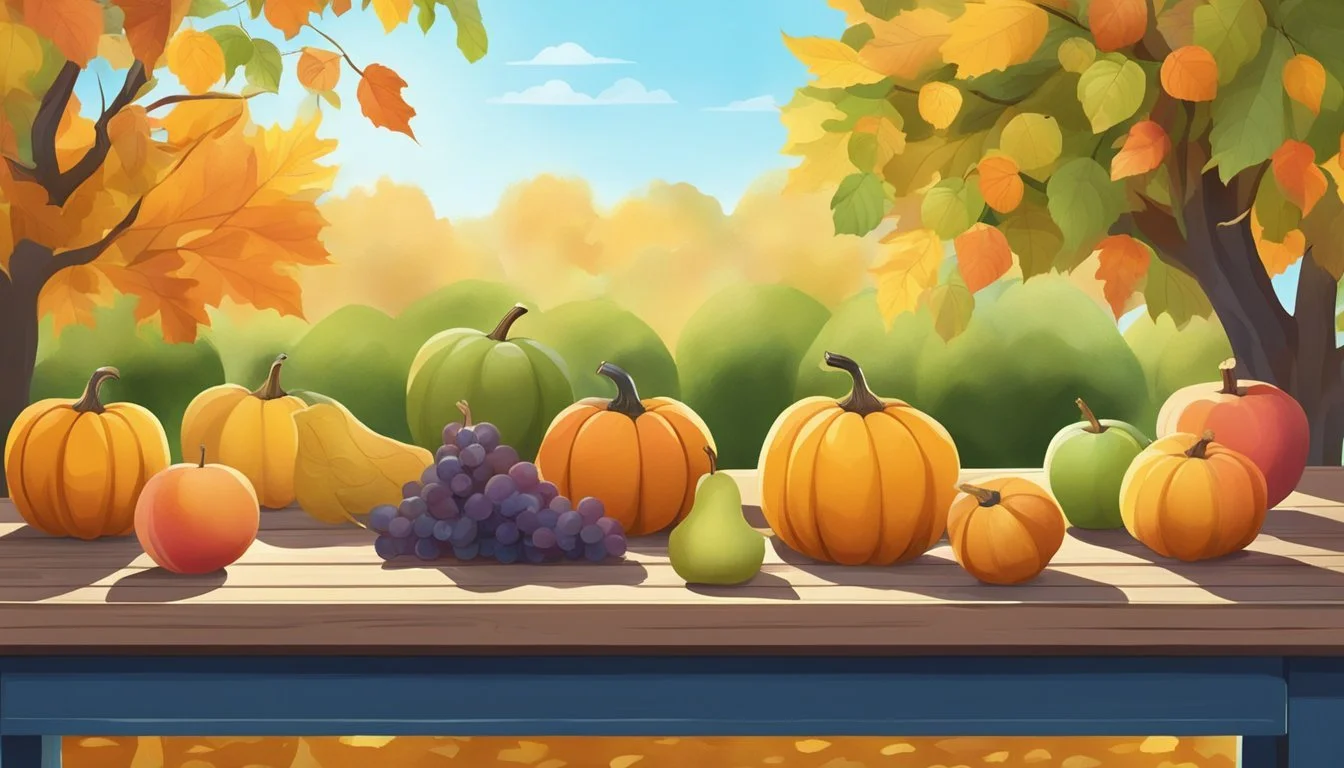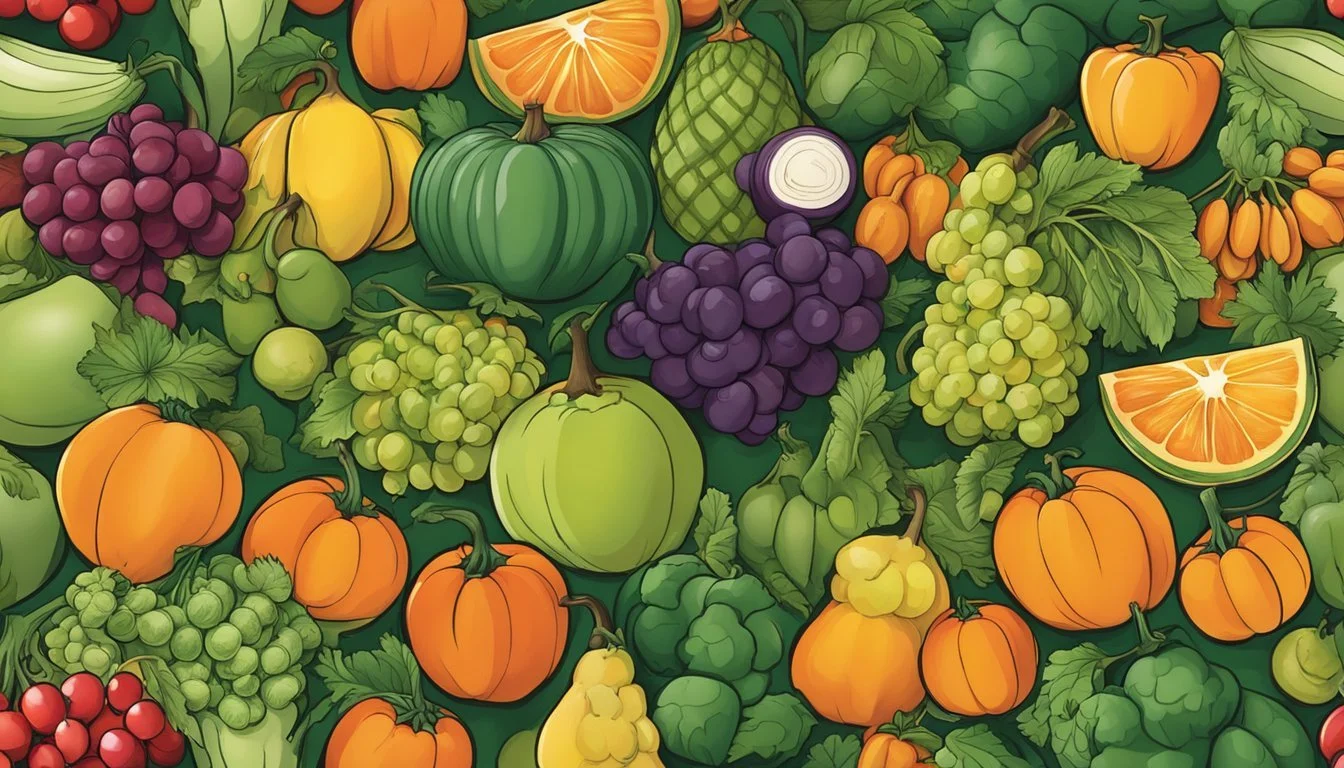Missouri Seasonal Fruit & Vegetables in October
A Guide to Autumn Harvests
This Article is Part of our Missouri Seasonal Fruit & Veg Calendar
Missouri offers a rich tapestry of produce that reaches its peak in October, marking a season where the state's farmlands yield some of the freshest and most diverse selections of fruits and vegetables. During this month, the vibrant fall harvest is in full swing, and local markets brim with a variety of produce that is not only flavorful but also nutritiously packed due to its seasonal ripeness.
Vegetables such as broccoli and Brussels sprouts (how long do brussels sprouts last?) are at their prime, providing crisp textures and deep flavors ideal for hearty autumn recipes. As the leaves change colors, October also ushers in the last of the plump, sweet blackberries and apples (how long do apples last?), perfect for homemade pies and preserves. Local orchards and farms invite consumers to experience the fresh taste of seasonal produce directly from the source.
Engaging with Missouri's October bounty supports not only local agriculture but also promotes a healthier lifestyle through the consumption of fresh, minimally processed produce. The seasonal calendar in Missouri encourages individuals to incorporate a variety of fruits and vegetables into their diets, enhancing meals with both traditional and innovative culinary uses.
Seasonal Overview
October in Missouri ushers in the heart of the fall harvest season. They witness a variety of fruits and vegetables reaching their peak quality and flavor.
Fall Harvest Timing
In Missouri, the fall harvest is a busy time for farmers and gardeners alike, as many summer crops come to the end of their cycle and fall varieties hit their stride. The transition from summer to fall brings a shift in the harvest schedule, with October often being the last chance to gather summer produce before the first frost arrives.
October's Seasonal Picks
Fruits:
Blackberries: End of Season
Blueberries: End of Season
Peaches: End of Season
Cantaloupes (how long does cantaloupe last?): Harvest ends
Vegetables:
Beets: Available
Broccoli: Available
Brussels Sprouts: Beginning of Season
Cabbage: Available
Farmers' markets and local produce aisles in October feature these in-season highlights, ensuring that consumers have access to fresh and flavorful produce.
Fruit in Season
In Missouri, October is a thriving month for fruit harvests, showcasing a variety of seasonal favorites that offer fresh flavors and nutritional benefits. The orchards and farms are abundant with crisp apples, juicy pears, and unique persimmons.
Apples
Missouri orchards harvest a myriad of apple varieties in October. Consumers can expect to find the likes of Crispin, Braeburn, Granny Smith, Macoun, and Fuji. Apples are versatile fruits, perfect for fresh eating, baking, or preserving.
Pears
Pears are another fruit coming into season during the autumnal month. They're excellent for both eating fresh and cooking. Varieties like Bartlett and Bosc reach their peak in October, offering a sweet and juicy experience.
Persimmons
A less common but delightful fruit harvested in October is the persimmon. Missouri-grown persimmons are typically ready for picking this month. They are known for their vibrant orange color and sweet, honey-like flavor when fully ripe.
Vegetables and Greens
In Missouri, October brings a bountiful harvest of robust root vegetables, nutritious leafy greens, and hearty cruciferous vegetables. Gardeners and consumers can look forward to fresh produce that thrives in the cooling temperatures of the fall season.
Root Vegetables
Root vegetables like carrots and potatoes reach their prime in October. These vegetables are staples in fall cooking, known for their long shelf life and versatility in dishes.
Carrots: Sweet and crunchy, ideal for salads, stews, and as snacks.
Potatoes: Available in several varieties, perfect for baking, mashing, and roasting.
Leafy Greens
A cooler climate is ideal for leafy greens, making them particularly tender and flavorful during this time.
Lettuce: Crisp and fresh, a variety of lettuce is harvested for salads and garnishes.
Spinach: High in iron and perfect for salads, sautéing, or adding to smoothies.
Kale: Nutrient-dense and suitable for chips, salads, and cooked dishes.
Cruciferous Vegetables
Missouri's October harvest includes an array of cruciferous vegetables, known for their health benefits and rich flavors.
Broccoli: Offers high nutritional value and is great whether steamed, roasted, or used in soups and casseroles.
Cabbage: Versatile for coleslaw, fermented foods (What wine goes well with fermented foods?) like sauerkraut, or cooked meals (how long do cooked meals last?).
Herbs and Specialty Produce
In October, Missouri's climate allows for the thriving growth of a range of herbs and specialty produce, distinguished by their high quality and diverse variety. This section provides insights into culinary herbs, edible flowers, and exotic varieties available in the region.
Culinary Herbs
Missouri gardens in October continue to yield an impressive array of culinary herbs. Basil (how long does basil last?) remains a popular choice for gardeners, thriving in the state's autumn climate, while cilantro and parsley typically reach their full flavor potential around this time. Consumers value the fresh, aromatic quality these herbs contribute to fall cuisine.
Culinary Herbs Available:
Basil
Cilantro
Parsley
Edible Flowers
Chefs and home cooks alike can embellish their dishes with edible flowers, adding both visual appeal and subtle flavors. In Missouri, edible flowers can usually be found fresh at local markets. The fall season encourages blossoming varieties that can withstand the cooler October temperatures.
Common Edible Flowers:
Nasturtiums
Marigolds
Exotic Varieties
For those with adventurous palates, Missouri offers exotic produce that may not be staples in every kitchen. The term "exotic" varies by region, but typically includes fruits, vegetables, or herbs not commonly grown in the area. October's moderate weather supports the growth of such specialty items, although availability can differ based on local farmers' cultivation choices.
Examples of Exotic Varieties:
Lemongrass
Harvesting and Storage
October in Missouri is a significant time for gardeners and farmers as they gather the season's bounty and prepare for storage. Knowing when and how to correctly harvest produce is crucial for maximizing both flavor and shelf life.
Proper Techniques
Harvesting should be done with care to avoid damaging the produce or the plant. Broccoli, for instance, should be picked regularly to encourage the production of side shoots. Fruits like persimmons are best harvested once they soften; some Missouri growers opt to collect them after they have naturally fallen from the tree.
When it comes to pumpkins and winter squash, they must be picked before the first frost to prevent spoilage and can be stored for later use. It is important to leave an inch or two of stem on each fruit to improve their storage capabilities.
After harvesting, vegetables such as onions should be allowed to dry. Once their tops fall over and the necks shrivel, they can be dug up, and the tops removed. Then place them in shallow boxes or mesh bags and let them cure in a dry, ventilated space for several weeks.
Preservation Methods
The key to prolonging the life of fruits and vegetables lies in proper preservation. Two common methods are freezing and canning.
Freezing not only retains the nutritional value of vegetables but also their texture and flavor if done correctly. Blanching vegetables before freezing can help preserve their quality. It involves briefly boiling the vegetables and then plunging them into ice water before packing them for the freezer.
Canning is another reliable preservation method. Vegetables and fruits can be made into pickles or jam, and sealed in sterilized jars. This method ensures that Missouri’s harvest can be enjoyed throughout the year. A balance of water, sugar, and pectin is important for jams, while a vinegar solution is essential for pickling to prevent bacteria growth and spoilage.
Using these methods, gardeners can effectively extend the enjoyment of Missouri's October harvest well into the colder months.
Missouri's Agricultural Landscape
Missouri's robust agricultural sector is characterized by diverse farming practices and regional produce that capitalize on the state's rich soil and seasonal climate. As October arrives, the focus of both gardeners and commercial farmers shifts to the harvest of fall crops, while markets brim with the season's bounty.
Local Farming Practices
Missouri farmers apply a blend of traditional and modern techniques to cultivate a wide range of fruits and vegetables. The state's agricultural model supports both large-scale operations and smaller, family-owned farms. This includes the practice of sustainable agriculture, with a focus on crop rotation, conservation tillage, and integrated pest management. The use of greenhouses and cold frames extend the growing season for certain crops, ensuring greater availability at local markets.
Regional Produce Variations
Given Missouri's varied climate zones, the crop availability in October can differ significantly by region. Here are some highlights across the state:
Northern Missouri:
Apples, pears, and root vegetables like sweet potatoes and turnips prevail in cooler conditions.
Central Missouri:
A wider variety retains warmth longer, supporting crops like tomatoes, peppers, and squash.
Southern Missouri:
The milder climate extends the season for berries and allows for a second planting of crops such as cucumbers and green beans.
Local markets throughout the state reflect these regional variations, offering consumers access to fresh, locally-grown produce well-suited to Missouri’s October climate.
Planning and Preparation
In October, Missouri gardeners should focus on planting and harvesting seasonal produce that will not only provide rich flavor but also contribute to lowering the family food bill. Precise planning ensures a bountiful garden that can be transformed into delicious meals.
Home Gardening Tips
When starting a garden in October, one should consider both immediate harvests and preparations for the next growing season. Gardeners typically plant garlic and shallot bulbs at this time as they require the cooler temperatures to develop. Existing vegetation should be cleared, and soil testing is recommended to determine if any amendments are necessary. Fertilization and tilling integrate these amendments and prepare the soil for planting. Efficient planning incorporates crop rotation and succession planting to maximize garden productivity. Further, continuing to harvest crops like broccoli promptly can stimulate the growth of additional side shoots.
Detailed planning for a garden must include:
Planting: Garlic, shallots
Harvesting: Broccoli, persimmons (best when soft)
Soil preparation: Testing, amending, tilling
Winterization: Protecting tools and non-seasonal plants
Seasonal Recipes
Harvested produce in October can be directly used in recipes that bring out their natural flavors while preserving their nutrients. Gardeners can add fresh persimmons to desserts or salads for a sweet, honey-like taste. Homegrown broccoli can be incorporated into numerous dishes ranging from stir-fries to soups. One can diversify their culinary repertoire by using seasonal vegetables which not only enhances the flavor of dishes but also makes the most of the garden's offerings. A gardener's harvest can thus provide the ingredients for recipes that are both cost-effective and flavorful for the family table.
Seasonal ingredients commonly used in recipes:
Persimmons: Salads, desserts
Broccoli: Stir-fries, soups, side dishes








